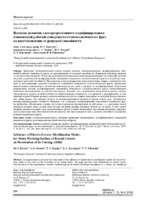| dc.contributor.author | Киселев, М. Г. | |
| dc.contributor.author | Монич, С. Г. | |
| dc.contributor.author | Богдан, П. С. | |
| dc.contributor.author | Корчигин, Д. Л. | |
| dc.contributor.author | Ефименко, В. В. | |
| dc.coverage.spatial | Минск | ru |
| dc.date.accessioned | 2020-08-04T07:14:31Z | |
| dc.date.available | 2020-08-04T07:14:31Z | |
| dc.date.issued | 2020 | |
| dc.identifier.citation | Влияние режимов электроэрозионного модифицирования изношенной рабочей поверхности стоматологических фрез на восстановление ее режущей способности = Influence of Electro-Erosive Modification Modes for Worn Working Surface of Dental Cutters on Restoration of its Cutting Ability / М. Г. Киселев [и др.] // Наука и техника. – 2020. – № 4. – С. 288-296. | ru |
| dc.identifier.uri | https://rep.bntu.by/handle/data/77402 | |
| dc.description.abstract | Выполнена экспериментальная оценка влияния режимов электроэрозионного модифицирования изношенной рабочей поверхности фрезы на восстановление ее режущей способности. Приведены основные сведения о стоматологических фрезах. Изложены положения методики проведения экспериментальных исследований, включая описание устройства для модифицирования изношенной поверхности стоматологической фрезы и устройства определения ее режущей способности. Представлены и проанализированы экспериментальные данные, отражающие влияние на восстановление режущей способности изношенной поверхности стоматологической фрезы, напряжения накопительного конденсатора и количества наносимых на нее лунок в процессе ее модифицирования. Определены рациональные режимы модифицирования изношенной поверхности стоматологической фрезы, обеспечивающие наибольшее восстановление ее режущей способности. Показано, что с повышением напряжения возрастает энергия электрического разряда, воздействующего на обрабатываемую поверхность, что приводит к формированию на ней единичной лунки большего размера, включая наплывы металла по ее краю, выходящие за исходный контур изношенных зубьев фрезы. Эти наплывы металла на модифицированной поверхности фрезы играют роль своеобразных режуще-деформирующих элементов. Выявлено, что в процессе модифицирования изношенной поверхности фрезы необходимо обеспечивать условие отсутствия перекрытия формируемых на ней лунок, т. е. расстояние между центрами соседних лунок должно быть больше или равно размеру наплывов металла по их краям. В этом случае наплывы металла сохраняют свою первоначальную форму и имеют наибольшую при данных параметрах импульса высоту, благодаря чему обеспечивается более высокая, чем при перекрытии лунок, режущая способность модифицированной поверхности фрезы. | ru |
| dc.language.iso | ru | ru |
| dc.publisher | БНТУ | ru |
| dc.title | Влияние режимов электроэрозионного модифицирования изношенной рабочей поверхности стоматологических фрез на восстановление ее режущей способности | ru |
| dc.title.alternative | Influence of Electro-Erosive Modification Modes for Worn Working Surface of Dental Cutters on Restoration of its Cutting Ability | ru |
| dc.type | Article | ru |
| dc.identifier.doi | 10.21122/2227-1031-2020-19-4-288-296 | |
| local.description.annotation | An experimental assessment has been made of the influence of electro-erosive modification modes for worn working surface of an cutter on the restoration of its cutting ability. The paper provides basic information on dental cutters. The provisions of the experimental research methodology are described, including a description of a device for modifying the worn surface of a dental cutter and a device for determining its cutting ability. Experimental data are presented and analyzed that reflect an effect on restoration of a cutting ability of a worn surface of a dental cutter, voltage of a storage capacitor and number of holes applied to it during its modification. Rational modes of modifying a worn-out surface of a dental mill that provide the greatest recovery of its cutting ability have been determined in the paper. It has been shown that with increasing voltage, the energy of the electric discharge acting on the treated surface increases, which leads to the formation of a single hole of a larger size on it, including metal flows along its edge that extend beyond the initial contour of the worn cutter teeth. These metal flows on the modified surface of the cutter play the role of peculiar cutting and deforming elements. It has been revealed that in the process of modifying the worn surface of the cutter, it is necessary to ensure that there is no overlap of the holes formed on it, i.e. the distance between the centers of adjacent holes should be greater than or equal to the size of metal deposits at their edges. In this case, the metal flows retain their original shape and have the highest height at these pulse parameters, which ensures a higher cutting ability of the modified cutter surface than when the holes are overlapped. | ru |

